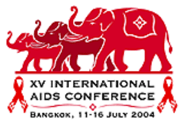 |
 |
 |
| |
Lipids Changes in Reyataz Expanded Access Program
|
| |
| |
|
|
| |
| |
 |
|
| |
| |
Reported by Jules Levin
"Improvement in Hyperlipidemia Following Switch of Antiretroviral (ARV) Therapy to an Atazanavir-based HAART Regimen: Experience from the U.S. Atazanavir Early Access Program (EAP)"
G Thal1, J Maa1, M. McManus 1, L Bessen2, L Abrams3, Cooney E3, S Hodder1
1Bristol-Myers Squibb Company, Plainsboro, NJ, 2Bristol-Myers Squibb Company, Lawrenceville, NJ, 3Bristol-Myers Squibb Company, Wallingford, CT
The ATV EAP is an ongoing, open label, single arm, multinational early access program for HIV infected individuals with treatment failure due to ARV resistance, hyperlipidemia, other ARV toxicity, or problems with adherence. The U.S. EAP enrolled patients from May 2002 until June 2003.
Clinical data on individuals enrolled in the EAP due to hyperlipidemia on prior regimens were analyzed and were reported in this poster by BMS at the Bangkok XV IAC. Reporting of laboratory values, including lipids, viral load and CD4 cell count, were not mandatory. The use of protease inhibitors (PIs) is frequently associated with hypercholesterolemia and hypertriglyceridemia. ATV has minimal effects on lipids in ARV-naïve and -experienced patients.
3,610 subjects enrolled in the U.S. EAP from May 2002 to June 2003. Hyperlipidemia was the reason for enrollment in 567 subjects. Baseline and Week 12 lipid data is available for 350 subjects (W eek 8 lipid data carried forward if Week 12 data not available; lipid analysis was not mandatory at study visits). Here is the poster report from BMS.
Baseline Characteristics
|
Baseline Characteristics
|
n=350
|
|
Mean Age (years)
|
47
|
|
Male
|
95%
|
|
Mean Total Cholesterol (mg/dL)
|
253
|
|
Mean LDL Cholesterol (mg/dL)
|
130
|
|
Mean HDL Cholesterol (mg/dL)
|
38
|
|
Mean Triglycerides (mg/dL)
|
693
|
|
Mean Non- HDL (mg/dL)
|
213
|
|
Mean HIV RNA (log10 copies/mL)
|
2.9
|
|
Mean CD4 Count (cells/mm3)
|
456
|
3rd Agent Prior to EAP Entry
|
Antiretroviral
|
Percent of Patients
|
|
|
n=350
|
|
PI
|
|
|
APV (APV/r)
|
9% (4%)
|
|
LPV/r
|
37%
|
|
IDV (IDV/r)
|
8% (3%)
|
|
SQV (SQV/r)
|
7% (5%)
|
|
NNRTI EFV
|
15%
|
|
NFV
|
9%
|
|
NVP
|
10%
|
Tenofovir (TDF) was the most commonly used NRTI in the ATV -based EAP regimen. At the time the EAP was initiated, the drug interaction with TDF was not available. Although it is now recommended that ritonavir-boosted ATV (ATV/r) be used with TDF due to this drug interaction, AT V/r was not initially available in the EAP. Unboosted ATV was used in approximately 90% of subjects reported on here.
ARVs in EAP Regimen (= 5% of subjects)
n=270, missing data = 80
|
NRTI
|
|
|
TDF
|
75%
|
|
ABC
|
37%
|
|
AZT/3TC
|
5%
|
|
AZT/3TC/ABC
|
7%
|
|
ddI
|
24%
|
|
d4T
|
17%
|
|
3TC
|
42%
|
|
|
|
|
NNRTI
|
|
|
EFV
|
7%
|
|
NVP
|
7%
|
|
|
|
|
PI
|
|
|
SQV
|
11%
|
|
RTV
|
8%
|
Mean fasting total cholesterol (TC), LDL cholesterol (LDL-C), triglycerides (TG) and non-HDL-C decreased from baseline to Week 12.
The mean change in:
--TG from baseline to Week 12 was -386 mg/dL, from 693 to 307
-- total cholesterol was from 253 to 189 (n=343)
-- LDL was from 130 to 105 (n=166)
-- HDL was from 38 to 37 (n=305
-- non-HDL from 213 to 154 (n=304)
Decreases in fasting TC and TG were seen in subjects taking both ATV and ATV/r based regimens. HDL-C showed little or no change in both groups.
Fasting Lipid Profiles at Baseline and Week 12 in Subjects Receiving ATV
Total chol: from 251 to 187
LDL-C: from 131 to 105
TG: from 700 to 297
HDL-C: from 38 to 36
Fasting Lipid Profiles at Baseline and Week 12 in Subjects Receiving ATV/r
Total chol: from 263 to 222 (n=22)
LDL-C: from 104 to 106 (n=14)
TG: from 684 to 447
HDL-C: from 38 to 38 (n=22)
Mean HIV-RNA remained stable from baseline to Week 12 (-0.3 log10 copies/mL) (n = 239).
Mean CD4 count increased slightly (+ 8.2 cells/mm3) (n = 259).
AUTHOR'S CONCLUDED
Substitution of ATV in the HAART regimen of patients with hyperlipidemia on ARV therapy resulted in improvements in the fasting lipid profile, with the greatest improvements seen in triglycerides and total cholesterol.
Fasting lipid profiles improved with the substitution of either ATV or ATV/r.
Virologic and immunologic control was maintained following the s witch to ATVbased regimens.
Substitution of ATV or ATV/r should be considered for patients experiencing hyperlipidemia on current antiretroviral regimens.
|
| |
|
 |
 |
|
|